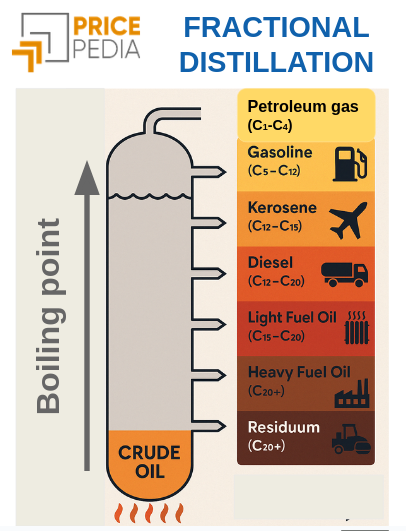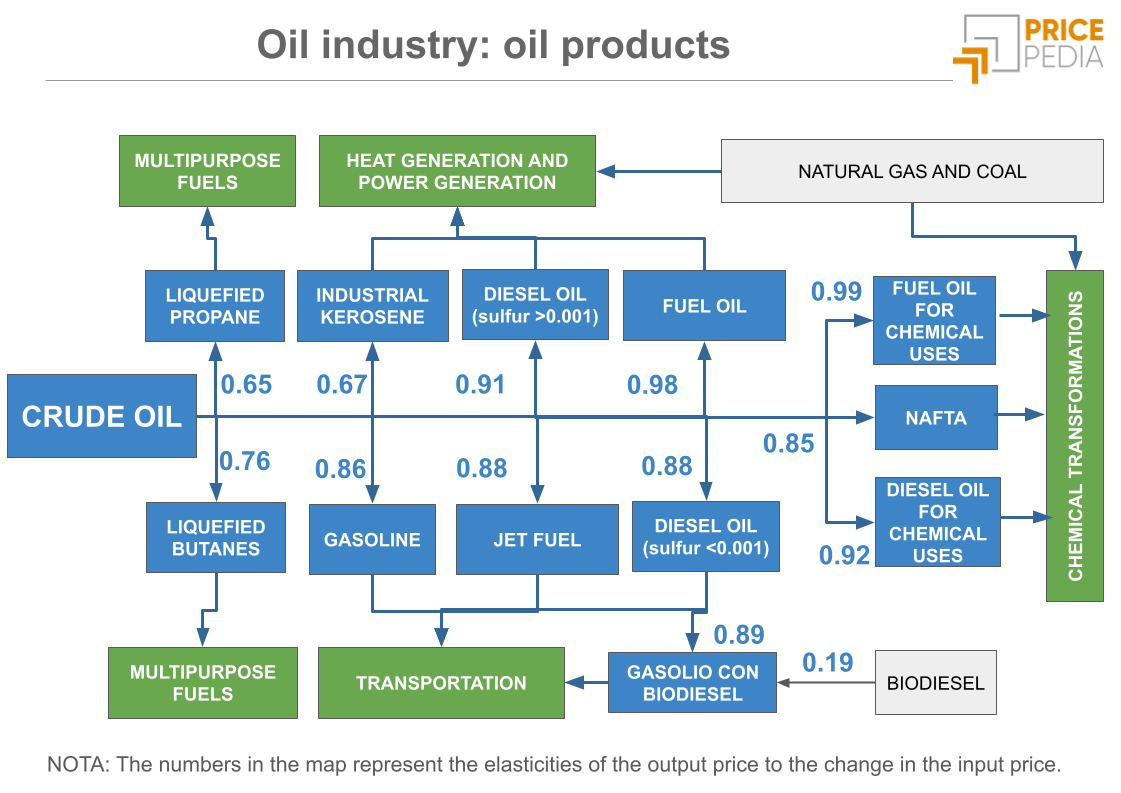From oil to petroleum products: the energy supply chain
An econometric analysis of the transmission of oil prices to derivative products
Published by Luigi Bidoia. .
Oil Cost pass-throughFrom Distillation to Products: A Matter of Molecules
Petroleum products are derived from the fractional distillation of crude oil, a process that separates the various components based on their boiling points. In a distillation column, the crude oil is heated and the different fractions separate as they rise through the column: the lighter ones evaporate first and are collected at the top, while the heavier ones remain at the bottom.
The chemical composition of the products depends on the number of carbon atoms in the hydrocarbon molecules:
- Petroleum gases (C1–C4), including propane and butane, used in liquefied form as fuels for domestic, industrial, and transportation purposes;
- Light oils, such as gasoline blends, made of molecules with 6 to 12 carbon atoms (C6–C12), highly volatile;
- Middle distillates, such as diesel, kerosene, and light fuel oil, with chains of 12 to 20 carbon atoms (C12–C20);
- Heavy residues, such as heavy fuel oil or bitumen, consisting of molecules with more than 20 carbon atoms (C20+).
These molecular characteristics influence the physical properties (such as density and viscosity) and the end uses of the various products. From these raw fractions, the petroleum industry performs further processes — such as cracking, reforming, or hydrotreatment — to obtain final products with the desired specifications.

A Functional Classification of Petroleum Products
The petroleum industry can be classified according to the intended use of the products derived from crude oil into two major categories:
- Fuel products: used to generate energy, in the form of heat or mechanical power;
- Chemical feedstocks: used as raw materials in petrochemical industry processes.
Within the category of fuel products, it is useful to distinguish between:
- Fuels: used to power internal combustion engines (gasoline, automotive diesel, LPG, jet fuel);
- Other fuels: used for heat generation in heating systems or thermoelectric power plants (fuel oil, heating diesel, industrial kerosene).
However, this functional classification is not always rigid. Some products derived from crude oil can fall into more than one category, depending on their technical characteristics, level of refinement, and end use.
For example, fuel oil is typically used to produce heat or energy, but there are also specific types used as chemical feedstocks in certain industrial processes.
Kerosene is another illustrative case: in its highly refined form (jet fuel), it is used in aircraft turbine engines; in its industrial form, which is less refined, it is used as a heating fuel.
Diesel is perhaps the most versatile product. Ultra-low sulfur diesel (≤10 ppm or ≤0.001%) is mainly used as fuel for road transport, in line with European environmental standards. Heating diesel, by contrast, is classified as a fuel: it is chemically very similar to automotive diesel but differs almost entirely for fiscal and administrative reasons, especially due to the lower excise duty applied. Finally, there are special types of diesel used primarily as chemical feedstocks.
An even more versatile group includes propane and butane gases, which, thanks to their physical properties, can be liquefied and easily transported. They are widely used for domestic, industrial, and even automotive applications. When combined, they are marketed as LPG (Liquefied Petroleum Gas), a flexible energy solution suitable for a broad range of uses.
Cost Pass-Through of Oil Price
The following diagram presents a functional classification of petroleum products, enriched with a key economic indicator: the price elasticity of each derivative with respect to the price of crude oil. The numerical values indicate how much the customs price of a product (before the application of excise duties, VAT, and distribution margins) changes in response to fluctuations in the price of crude oil.

For example, a gasoline elasticity of 0.86 means that a 10% change in the price of crude oil results, on average, in an 8.6% change in the customs price of gasoline. The fact that the elasticity is less than 1 reflects the presence of additional cost components in the final price, beyond those strictly related to the crude oil itself — such as further processing steps and logistical costs.
In the case of gasoline, for instance, the light oils obtained from primary distillation must undergo additional refining processes — including catalytic reforming, isomerization, and blending — in order to meet the technical and environmental standards required for use in internal combustion engines. These post-distillation operations contribute to reducing the direct sensitivity of the gasoline price to changes in crude oil prices.
The analysis of elasticity values confirms the significant influence that changes in crude oil prices have on the pricing of petroleum derivatives. However, only in a few cases does elasticity approach 1. Among these, fuel oil stands out, as it shows an elasticity close to unity. This is because, among the various petroleum products, it requires the fewest post-distillation processing steps.
An element shared by most petroleum derivatives, as revealed by econometric estimates, is the significant correlation between their EU customs prices and the European industrial cycle. The transmission channel operates through internal demand: during phases of industrial expansion, demand for petroleum derivatives tends to increase — either directly or indirectly — putting upward pressure on prices. Conversely, during periods of economic slowdown or contraction, demand weakens, leading to a decline in prices.
Conclusions
Crude oil is a raw material composed of a wide range of different molecules, all consisting of carbon and hydrogen atoms. These molecules can be separated through a process of fractional distillation, which isolates the lighter components from the heavier ones based on their boiling points.
From a commercial perspective, petroleum derivatives are classified not only by their chemical composition but also by their functional use. They are generally grouped into:
- Fuels used in transportation,
- Non-transport fuels used to generate heat and electricity,
- Feedstocks for chemical transformation, used in the petrochemical industry.
The prices of all petroleum derivatives are strongly affected by fluctuations in crude oil prices, although elasticity values remain below 1 in most cases. Only fuel oil shows an elasticity close to unity. For all other products, elasticity typically falls within the 0.7–0.9 range, due to the presence of significant additional costs — including refining processes, logistics, and regulatory compliance — that add to the base cost of crude oil.


